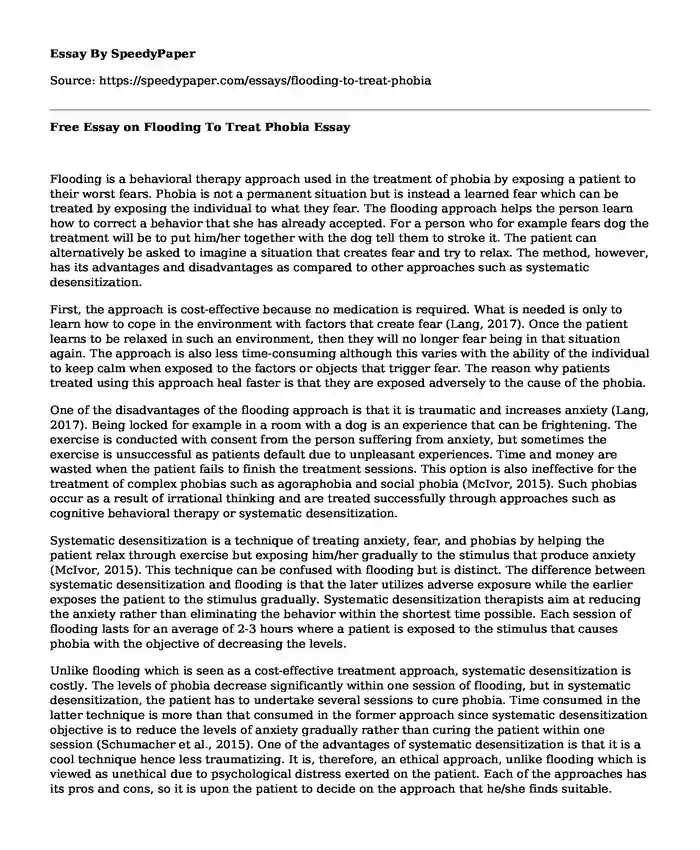
| Type of paper: | Essay |
| Categories: | Human behavior |
| Pages: | 3 |
| Wordcount: | 655 words |
Flooding is a behavioral therapy approach used in the treatment of phobia by exposing a patient to their worst fears. Phobia is not a permanent situation but is instead a learned fear which can be treated by exposing the individual to what they fear. The flooding approach helps the person learn how to correct a behavior that she has already accepted. For a person who for example fears dog the treatment will be to put him/her together with the dog tell them to stroke it. The patient can alternatively be asked to imagine a situation that creates fear and try to relax. The method, however, has its advantages and disadvantages as compared to other approaches such as systematic desensitization.
First, the approach is cost-effective because no medication is required. What is needed is only to learn how to cope in the environment with factors that create fear (Lang, 2017). Once the patient learns to be relaxed in such an environment, then they will no longer fear being in that situation again. The approach is also less time-consuming although this varies with the ability of the individual to keep calm when exposed to the factors or objects that trigger fear. The reason why patients treated using this approach heal faster is that they are exposed adversely to the cause of the phobia.
One of the disadvantages of the flooding approach is that it is traumatic and increases anxiety (Lang, 2017). Being locked for example in a room with a dog is an experience that can be frightening. The exercise is conducted with consent from the person suffering from anxiety, but sometimes the exercise is unsuccessful as patients default due to unpleasant experiences. Time and money are wasted when the patient fails to finish the treatment sessions. This option is also ineffective for the treatment of complex phobias such as agoraphobia and social phobia (McIvor, 2015). Such phobias occur as a result of irrational thinking and are treated successfully through approaches such as cognitive behavioral therapy or systematic desensitization.
Systematic desensitization is a technique of treating anxiety, fear, and phobias by helping the patient relax through exercise but exposing him/her gradually to the stimulus that produce anxiety (McIvor, 2015). This technique can be confused with flooding but is distinct. The difference between systematic desensitization and flooding is that the later utilizes adverse exposure while the earlier exposes the patient to the stimulus gradually. Systematic desensitization therapists aim at reducing the anxiety rather than eliminating the behavior within the shortest time possible. Each session of flooding lasts for an average of 2-3 hours where a patient is exposed to the stimulus that causes phobia with the objective of decreasing the levels.
Unlike flooding which is seen as a cost-effective treatment approach, systematic desensitization is costly. The levels of phobia decrease significantly within one session of flooding, but in systematic desensitization, the patient has to undertake several sessions to cure phobia. Time consumed in the latter technique is more than that consumed in the former approach since systematic desensitization objective is to reduce the levels of anxiety gradually rather than curing the patient within one session (Schumacher et al., 2015). One of the advantages of systematic desensitization is that it is a cool technique hence less traumatizing. It is, therefore, an ethical approach, unlike flooding which is viewed as unethical due to psychological distress exerted on the patient. Each of the approaches has its pros and cons, so it is upon the patient to decide on the approach that he/she finds suitable.
References
Lang, P. J. (2017). Stimulus control, response control, and the desensitization of fear. In Foundations of Behavioral Therapy (pp. 148-173). Routledge.
McIvor, A. (2015). A Rational Treatment for an Irrational Fear.
Schumacher, S., Miller, R., Fehm, L., Kirschbaum, C., Fydrich, T., & Strohle, A. (2015). Therapists' and patients' stress responses during graduated versus flooding in vivo exposure in the treatment of specific phobia: A preliminary observational study. Psychiatry research, 230(2), 668-675.
Cite this page
Free Essay on Flooding To Treat Phobia. (2022, Nov 29). Retrieved from https://speedypaper.com/essays/flooding-to-treat-phobia
Request Removal
If you are the original author of this essay and no longer wish to have it published on the SpeedyPaper website, please click below to request its removal:
- Essay Sample on the Play The Dog in the Manger
- Smoking - Moments of Satisfaction or Life-long Problems? Free Essay
- Free Essay on the Play - Man and Superman by Bernard Shaw
- Law Essay Sample: Declaratory Judgment, Counterclaim, Shrink-Wrap License
- Essay Sample on Reflection of My Resume
- Essay Sample: Is Hoarding a Kind of Cultural Illness in the United States?
- Essay Example on Amnesia Disorder to Healthy Memory
Popular categories




